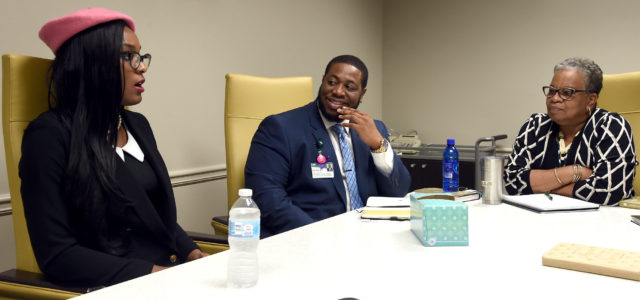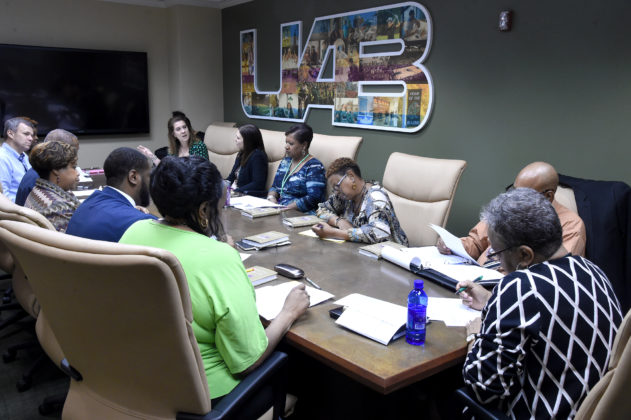
By Erica Wright
The Birmingham Times
Meet Jessica Valles who is a member of the UAB’s Office of Diversity, Equity, and Inclusion (ODEI) Keystone Fellows program. The program was launched last year to identify scholars interested in solving problems related to diversity, with an emphasis on higher education or local communities.
Valles, a fourth-year medical sociology doctoral student in her second year as a fellow, is doing research that focuses primarily on health services for immigrant and aging populations, especially in the area of mental health.
“Right now, I’m looking at different immigrant populations and [their] citizenship status and how mental health varies for those groups,” she said. “For the community, in particular, I look at under- and unemployed youth and focus on the trajectories they take in terms of employment and sustaining education.”
Valles is one of several talented students who work with ODEI, whose mission is to champion equity and inclusion, as well as advocate for inclusive excellence on behalf of UAB’s students, faculty, staff, and community partners.
“The idea is that people reach out to this office—and me, in particular—for advice and counsel on a host of issues,” said UAB Vice President for Diversity, Equity, and Inclusion Paulette Patterson Dilworth, PhD. “Everything we do in this office cuts across the entire enterprise, so everyone has access to us in that regard.”
A Day at the ODEI
During a recent tour of the ODEI, the Birmingham Times got a first-hand look at the group’s day-to-day activities.
We started the day at a morning staff meeting.
About a dozen ODEI staff members sat at a long conference table, while Dilworth, who has been in her position since January 2016, led the group in a dialogue about projects and a new process to recruit faculty. Then everyone in attendance updated the group about their respective projects.
Next on the agenda: a discussion about the group’s strategic diversity plan and goals for the next few years. Their priorities included creating a positive campus environment; increasing and providing access to diversity education; and communicating a clear statement of diversity, equity, and inclusion at UAB. Each ODEI initiative is designed to inspire equity and inclusiveness through shared values, such as integrity and respect.
Support Services
After the meeting, we got a look at some of the ODEI’s support services. First, we learned about the Jefferson County Youth Transportation Workforce Development (JCYTWD) Program, which equips young adults with the resources and guidance and works with the Alabama Department of Transportation (ALDOT).
UAB junior DeJon Taylor has been an ALDOT intern for six months, and said the program has been a worthwhile experience.
”I was placed in preconstruction,” Taylor said. “During my time [with the department], I was able to do cost estimates; review plans for upcoming projects; edit projects using MicroStation, [a software platform for design and drafting]; and go on site visits and interact with construction workers on the project.
“It was eye-opening. … I learned a lot about what ALDOT engineers do, but I also learned things outside of the job, such as office etiquette, time management, and how to advance my engineering career. Overall, the internship prepared me to understand what I need to do to become a successful engineer.”
Ordrell Smith, ODEI Program Manager and JCYTWD Director, explained that the program is open to students from high schools in the metro area.
“We also have a component through which we do internships with community colleges [across] the state and four-year institutions from Mobile to Muscle Shoals,” he said. “We’re winding up now with a six-month internship, … and we’ve been very fortunate that some of the interns got jobs before the internship expired.”
The JCYTWD has been around for 22 years and “provides 17 six-week lectures, during which participants … explore the transportation industry [and] are given a tour of an active transportation-related business as a field trip,” according to its website. Participants also acquire valuable life skills and learn about career opportunities in the transportation industry.
During our visit we also learned about Disadvantaged Business Enterprise Support Services (DBESS). This group provides technical and management assistance to minority- and women-owned business enterprises interested in working with ALDOT.
Keystone Fellows Program
We also got a look at the Keystone Fellows Program, which has three Fellows enrolled in UAB doctoral programs.
In addition to Valles, the program has Celine Atkins, a third-year doctoral student and second-year fellow, who is studying developmental psychology; some of her research focuses on topics of popular culture and how they relate to the community at large.
Another fellow, Joydan Jones, is a second-year doctoral student in the school of engineering. A first-year fellow studying material science and engineering, her research focuses on science, technology, engineering, and mathematics (STEM)-related community outreach, which aims to create pipelines between big universities and STEM programs.
“We try to find students who have a demonstrated interest in developing or implementing sustainable approaches to complex societal issues, especially those affecting historically underserved and marginalized populations,” said UAB Assistant Vice President for Campus and Community Engagement, Brandon L. Wolfe, PhD, who also works with the ODEI.
Collaboration and Cooperation
As our day at the ODEI came to an end, Dilworth reiterated the need of diversity in higher education.
”Diversity and inclusion are important because U.S. workplaces and schools increasingly consist of various cultural, racial, and ethnic groups, in addition to other diverse characteristics and demographics that are not always visible,” she said. “I believe there is much we can learn from one another, but first we must have a level of understanding about each other in order to facilitate courageous and critical dialogue to foster collaboration and cooperation.”
Click here to read more stories about UAB: Critical Conversations; BMEN.












